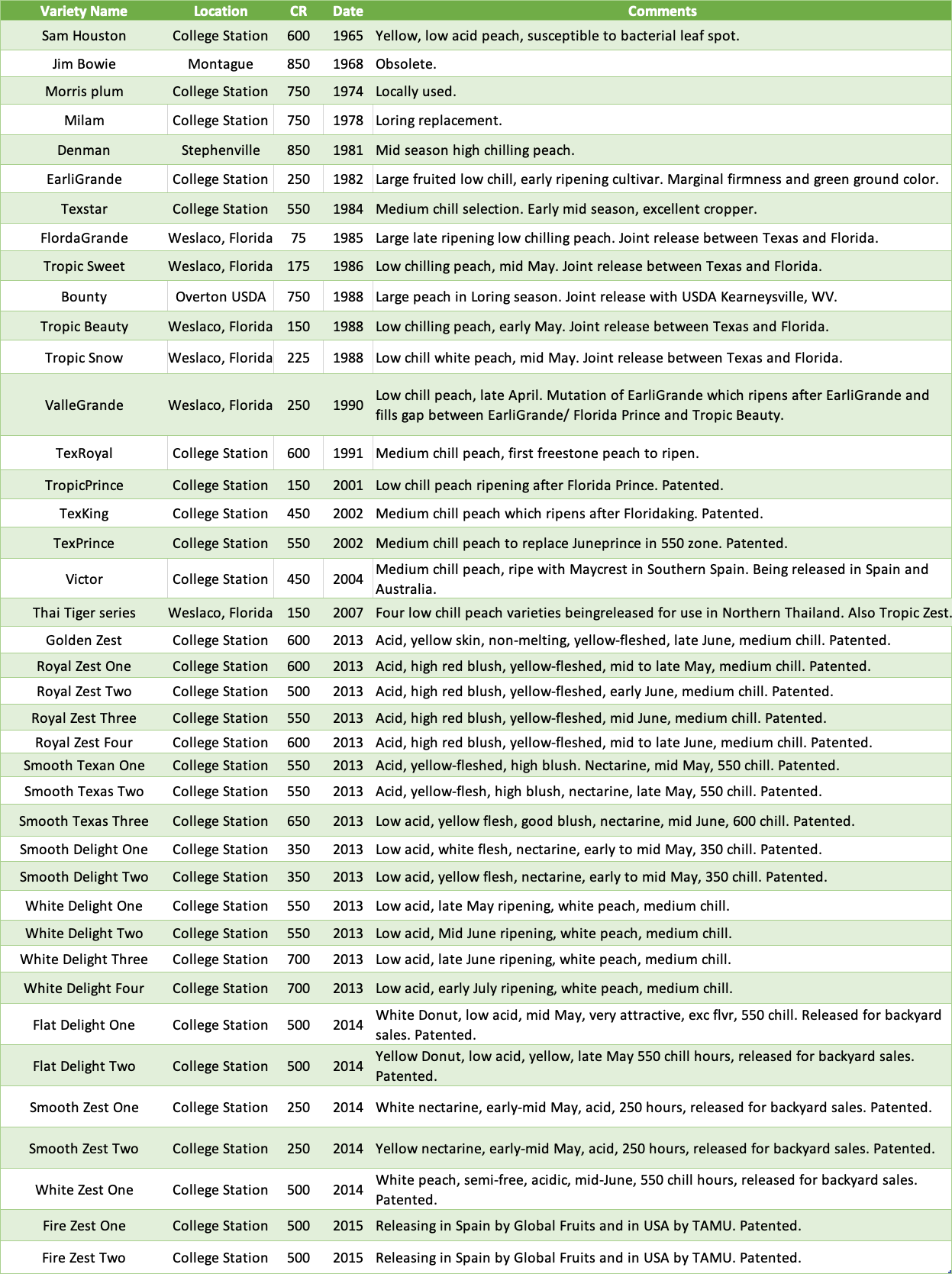The History of the Stone Fruit Breeding Program
The first peach varietal trial in Texas was planted in 1899 and the stone fruit breeding program was initiated in 1935 by S. H. Yarnell. The objective of this program was to develop commercial yellow-fleshed freestone peaches adapted to the medium chill zone (350 to 650 CR) of south-central Texas. The initial progress was slow because few resources were devoted to this breeding effort. In 1965, H. H. Bowen took the reins of the breeding program. Dr. Bowen worked closely with the stone fruit breeders in New Jersey (L. F Hough) and Florida (R. Sharpe and W. Sherman) and released a range of varieties for the high chill (‘Milam’) to the low chill (‘EarliGrande’) zones. ‘EarliGrande’, although an obsolete variety at present, was a major advance for low chill varieties at the time of its release (Table 1). Dr. Bowen retired in 1980 and in 1983 David Byrne joined the faculty of the Department of Horticultural Sciences and reestablished the breeding program.
The initial focus was the development of early ripening yellow-fleshed peaches adapted to the medium chill zone. This work led to the release of several varieties that are well adapted to this medium chill zone. The early releases were ‘Texstar’(1984) and ‘TexRoyal’(1991). Both cropped more consistently than the existing varieties. ‘TexRoyal’ also had more consistent shape than did ‘June Gold’, the commonly grown peach at the time of the release. In the early 2000s, two additional varieties were released. Both are yellow-fleshed peaches. ‘TexKing’ ripens as the major commercial variety (‘Flordaking’) finishes and ‘TexPrince’ is a better-adapted alternative for ‘June Gold’ or ‘Juneprince’.
In the 1980s, collaborative work between Dr. Robert Rouse in south Texas (Weslaco) and Wayne Sherman of the University of Florida resulted in the release of several low chill peach varieties. These include both the joint releases with Florida {‘FlordaGrande, (1985), ‘TropicSweet’ (1986), ‘TropicBeauty’, ‘TropicSnow’ (1988)} and a later ripening mutation of the ‘EarliGrande’ cultivar called ‘ValleGrande’ (1990). The initial objective of the breeding was to develop low chill varieties ripening after ‘Flordaprince’ and before ‘TropicBeauty’. The first of these selections to be released is ‘TropicPrince’ (2001) that is a yellow-fleshed peach that ripens with or slightly after ‘Flordaprince’. After this, a series of four low chill yellow-fleshed peaches were released in Thailand in collaboration with the Royal Agricultural Project in Northern Thailand where they have been developing alternative high value crops to poppy production. This series of peaches was released as the Thai Tiger peaches in Thailand and released as the Tropic Zest peaches in the USA (2007).
In the mid-1990s, Texas A&M University began to develop business collaborations with nurseries and growers to better utilize the selections that TAMU was developing as well as to generate funding to run the breeding research. At present, TAMU has collaborative testing/commercialization arrangements with partners in Spain, Brazil, Mexico, Morocco, Israel, Australia, and California. These collaborations have allowed the TAMU program to grow and expand the objectives beyond yellow-fleshed peaches to include additional work on white-flesh, nectarines, and pantao materials. This shift in emphasis has produced a series of recent releases that include the Royal Zest series (yellow-flesh, traditional acidity), Smooth Texan nectarines, Smooth Delight nectarines, Smooth Zest nectarines and Flat Delight peaches (subacid, flat peaches), White Delight peaches(subacid white peaches) and White Zest (traditional acidity, white peach). An additional set of selections are currently being tested in multiple locations and environments to identify the next series of low to medium chill peaches and nectarines to be released from this breeding program.
Objectives of the Program
Adaptation Traits
- Low (< 250 CR) and medium (350 – 650 CR) chill adaptation.
Resistance to bacterial leaf spot (Xanthomonas).
Fruit types
- Peaches and nectarines, Yellow, orange, white, and red flesh, Low and, high acid, Round and flat shapes
Horticultural traits
- Early ripening (<100 days). Ripening in April and early May in low chill zones and late April, May, and Early June in medium chill zones
- Increased post-harvest life by incorporating non-melting flesh and resistance to internal browning into the germplasm.
This work has resulted in the release of the listed varieties below.
